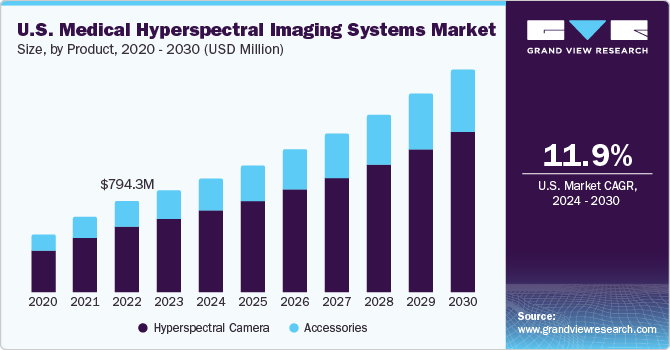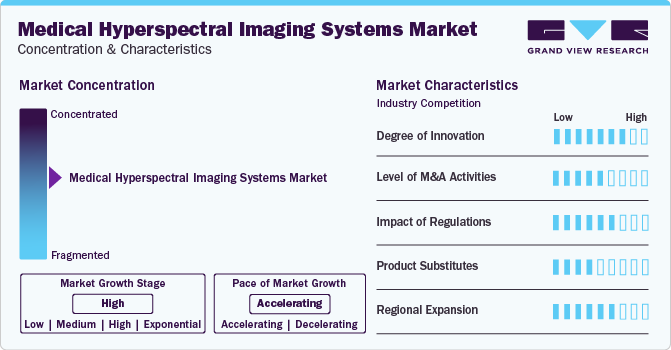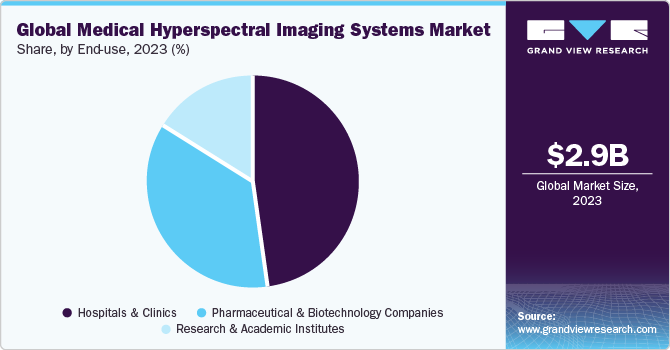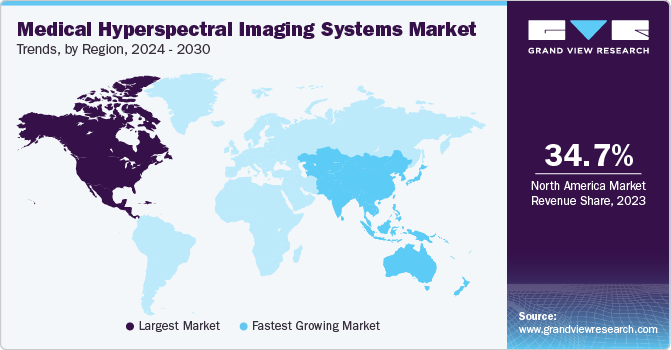- Home
- »
- Medical Devices
- »
-
Medical Hyperspectral Imaging Systems Market Size Report, 2030GVR Report cover
![Medical Hyperspectral Imaging Systems Market Report]()
Medical Hyperspectral Imaging Systems Market Analysis Report By Product (Hyperspectral Camera, Accessories), By Technology (Snapshot, Push Broom, Others), By Application, By End-use, And Segment Forecasts, 2024 - 2030
- Report ID: GVR-4-68040-240-2
- Number of Report Pages: 195
- Format: PDF, Horizon Databook
- Historical Range: 2018 - 2022
- Forecast Period: 2024 - 2030
- Industry: Healthcare
Market Size & Trends
The global medical hyperspectral imaging systems market size was estimated at USD 2.9 billion in 2023 and is expected to grow at a CAGR of 11.6% from 2024 to 2030. The growing need for non-invasive diagnostic methods, advancements in imaging technology, and increasing prevalence of chronic diseases are expected to drive market expansion. As healthcare providers and patients increasingly seek safer and more precise diagnostic tools, hyperspectral imaging systems offer promising solutions by providing detailed tissue information without invasive procedures. Moreover, continuous technological innovations in imaging technology enhance the capabilities and efficiency of hyperspectral imaging systems, further fueling their adoption across various medical specialties. These factors collectively contribute to the anticipated growth of this.

For instance, in January 2023, Panasonic Holdings Corp. unveiled the world's most sensitive hyperspectral imaging technology using compressed sensing in medical MRI scans. Hyperspectral imaging systems in medicine capture and process data from a wide range of wavelengths, providing detailed spectral information about tissues and lesions. These systems can differentiate between healthy and diseased tissues based on their unique spectral signatures, aiding in early disease detection and treatment monitoring. For instance, according to Springer Nature Limited in November 2023, hyperspectral simulated narrow-band images (NBI) generated using CycleGAN can be compatible with modern endoscopes, potentially improving doctor recognition rates and early esophageal cancer (EC) detection.
Furthermore, the development of this technology may enable its integration with AI for enhanced patient comfort and early symptom detection, potentially reducing the risk of patient mortality. With applications in fields, such as oncology, dermatology, neurology, and ophthalmology, medical hyperspectral imaging allows for non-invasive, real-time tissue characterization, guiding surgical procedures, and facilitating personalized treatment strategies. Hyperspectral imaging systems improve diagnostic accuracy and patient outcomes in various medical specialties by providing comprehensive insights into tissue composition and pathology.
For instance, in August 2023, Swift Medical Inc. introduced the Swift Ray 1 device, designed to attach to smartphones and link with the Swift Skin and Wound software. It captures medical-grade pictures, infrared thermography images (measuring body heat), and bacterial fluorescence images (revealing bacteria with violet light), eliminating the need for multiple costly devices and promoting the growth of hyperspectral imaging systems. The growing incidence of cancer is another key factor driving market growth. According to the Global Cancer Observatory (GCO), breast cancer, with an estimated 2,310,051 new cases in 2022, ranks as the most widespread cancer type among women globally.
Hyperspectral imaging holds promise in enhancing breast-conserving surgeries through real-time margin assessment. This capability allows surgeons to remove additional tissue if needed to achieve a negative resection margin. For instance, according to a study by the Multidisciplinary Digital Publishing Institute (MDPI) in April 2023, the approach based on hyperspectral unmixing showed excellent performance in classifying the measured locations on the resection surface of lumpectomy specimens using hyperspectral imaging. With the growing need for improved cancer diagnostics and therapies, the adoption of hyperspectral imaging systems is also anticipated to rise, fostering market growth.
Market Concentration & Characteristics
The market growth stage is high, and the pace of its growth is accelerating. The market has witnessed a high degree of innovation, marked by several instances of regulatory approvals, partnerships, and collaborations. In recent years, the market has seen a surge in the number of new product launches, making it increasingly challenging for market leaders to sustain themselves in the ever-changing market. However, leading players are investing heavily in R&D activities to develop advanced imaging technologies, which is expected to fuel market growth.

Technological advancements and product launches drive market growth. For instance according to Science X Network in February 2021, UCLA Samueli School of Engineering researchers have showcased an innovative method for spectroscopy using an AI-enabled on-chip spectrometer framework. This technology shows potential for use in environmental monitoring of gases and toxins, as well as in medical diagnostics for detecting different biomarkers using spectral data.
The market has witnessed significant innovation, driving advancements in diagnostic imaging technology. These innovations have led to the development of more precise and efficient imaging systems, enhancing diagnostic capabilities in various medical fields. For instance, in March 2023, a fascinating advancement is the rise of microsurgery, which is notable for its utilization of surgical microscopes to enhance precision by magnifying the surgical site. Coupled with innovative camera technologies, these advancements enable surgeons to reveal previously unseen details, promising a transformative impact on medical care
Several market players are engaged in a moderate level of merger and acquisition (M&A) activities. For instance, in November 2021, OmniVision Technologies, Inc. and Diaspective Vision GmbH partnered to develop the MALYNA system, a novel endoscopic camera based on proprietary multispectral imaging technology, combining OmniVision's expertise in digital imaging solutions with Diaspective Vision's prowess in medical camera systems
The market is highly impacted due to strict regulations. For instance, the U.S. Food and Drug Administration (FDA) has strict rules regarding the approval of medical devices. In February 2024, Proscia, a prominent digital and computational pathology solutions supplier, obtained FDA 510(k) approval for its Concentriq AP-Dx. The U.S. FDA approved this digital pathology solution for primary diagnostic use
Product substitutes have a moderate impact on the market. For instance, substitutes for medical hyperspectral imaging systems include alternative modalities, such as traditional visible light, infrared, and multispectral imaging. Diagnostic techniques like ultrasound, MRI, CT scans, and endoscopy may also be substituted in specific clinical applications. Emerging technologies, such as optical coherence tomography (OCT) and confocal microscopy offer alternatives for particular imaging needs. According to the German Cancer Research Center (DKFZ) and the Städtisches Klinikum Karlsruhe in March 2023, blood flow in the kidney can be observed in real-time without the need for contrast agents through a blend of multispectral imaging and AI
Regional Expansion:Regional expansion is anticipated to have a moderate to high growth impact on the market. Regional expansion provides market players with an opportunity to tap into previously untapped customer bases. This strategy enables them to strengthen their position in the global industry and increase their market share
Product Insights
The hyperspectral camera segment dominated the market in 2023 and accounted for the largest revenue share. It is expected to grow at the fastest CAGR of 11.9% from 2024 to 2030. Hyperspectral cameras in the medical field offer advanced imaging capabilities by capturing a broad range of spectral information across the electromagnetic spectrum. These cameras enable detailed analysis of biological tissues, organs, and processes based on their unique spectral signatures. Hyperspectral cameras provide high-resolution spatial and spectral data simultaneously in various medical applications, such as disease diagnosis, tissue characterization, surgical guidance, and wound assessment.
With their ability to detect subtle changes in tissue properties, these cameras enhance diagnostic accuracy and treatment efficacy, promising significant advancements in personalized medicine and clinical research. In January 2023, At the SPIE Photonics West biomedical optics and biophotonics exhibition, imec, a prominent research and innovation hub in nanoelectronics and digital technologies, showcases a promising advancement in the in-vivo detection of low-grade gliomas, slow-growing brain tumors. They achieved this breakthrough by integrating Imec's SNAPSCAN VNIR 150 hyperspectral camera onto a standard OR-approved surgical microscope. This camera provides precise clinical data, assisting surgeons in identifying intrinsic brain tumor boundaries accurately without labeling.
Technology Insights
The snapshot segment captured the largest share in 2023 and is expected to grow at the fastest CAGR of 12.2% from 2024 to 2030. Snapshot technology captures hyperspectral datacubes in a single snapshot, providing instant and comprehensive spectral information across a scene without scanning. This technology revolutionizes medical imaging by enabling real-time analysis of tissues, organs, and physiological processes with high spatial and spectral resolution. Traditional hyperspectral imaging systems often require time-consuming scanning procedures, where each pixel in the image is sequentially illuminated with different wavelengths of light. In contrast, snapshot technology significantly reduces acquisition time and improves efficiency.
For instance, in 2024, Optica Publishing Group introduced an innovative idea of a snapshot hyperspectral camera explicitly designed for retinal imaging. This camera concept is well-suited for ophthalmology as it can capture a broad spectral range and high-resolution images in a single snapshot. This capability minimizes motion artifacts while providing a comprehensive dataset suitable for human experts and machine algorithms analysis. In medical applications, snapshot technology facilitates dynamic imaging procedures, such as intraoperative surgical guidance, where real-time assessment of tissue perfusion, oxygenation levels, or biomarker distributions is critical. By providing instant feedback to clinicians, snapshot hyperspectral imaging systems enhance diagnostic accuracy, surgical precision, and patient outcomes.
Application Insights
The medical diagnostics segment accounted for the largest share in 2023 and is expected to register the fastest CAGR of 12.0% from 2024 to 2030. Medical hyperspectral imaging systems offer valuable applications in diagnostics across various medical fields. In dermatology, they aid in early skin cancer detection by analyzing lesions' spectral signatures. In gastroenterology, they identify abnormal tissue growths in the gastrointestinal tract. Ophthalmology benefits from the detection of retinal diseases like diabetic retinopathy. These systems provide detailed spectral information for precise diagnosis, guiding treatment decisions and improving patient outcomes.
For instance, according to the National Center for Biotechnology Information (NCBI) in January 2024, Hyperspectral imaging technology captured spectral data utilized in constructing a two-classification model for distinguishing normal and cancerous tissues and a four-classification model for identifying cancer types, both employing the improved deep residual network (IDRN). The precision of the two-class and four-class models stands at 0.947 and 0.965, respectively. Hyperspectral imaging facilitates precise diagnosis and typing of gastric cancer by extracting molecular information in real-time.
These findings underscore the effectiveness of hyperspectral imaging in diagnosing and differentiating gastric cancer types, suggesting its potential for aiding in medical diagnosis and treatment. With their non-invasive nature and high accuracy, medical hyperspectral imaging systems are revolutionizing medical diagnostics, offering clinicians powerful tools for detecting and managing various diseases and conditions. These advanced imaging systems offer detailed spectral analysis capabilities, allowing for precise identification and characterization of pharmaceutical products and ingredients. In quality assurance, hyperspectral imaging can detect contaminants, impurities, or defects in medications, ensuring product safety and efficacy.
Moreover, in drug testing, these systems aid in identifying and quantifying drugs and metabolites in biological samples. According to the Multidisciplinary Digital Publishing Institute (MDPI), in June 2021, UV hyperspectral imaging was utilized to characterize active pharmaceutical ingredients present in tablets. The combination of hyperspectral imaging with Principle Component Analysis (PCA) shows potential as an effective method for detecting and distinguishing all examined drug samples.
End-use Insights
The hospitals & clinics end-use segment accounted for the largest share of 48.6% of the overall revenue in 2023. These healthcare facilities use hyperspectral imaging systems for various diagnostic and therapeutic applications across multiple medical specialties. Hospitals employ these systems for precise diagnosis of diseases, such as cancer, dermatological conditions, and gastrointestinal disorders. Moreover, clinics integrate hyperspectral imaging into surgical procedures for real-time tissue characterization and identification of pathological tissues.

The versatility and accuracy of these systems make them a valuable tool for improving patient outcomes and advancing medical research in hospitals & clinics worldwide. The pharmaceutical & biotechnology companies segment is expected to register the fastest CAGR from 2024 to 2030. These companies use hyperspectral imaging systems to analyze pharmaceutical formulations, assess drug efficacy, and investigate cellular & molecular interactions. By employing hyperspectral imaging, they can expedite the drug discovery process, optimize manufacturing processes, and ensure the quality and safety of pharmaceutical products.
In addition, these companies collaborate with imaging system manufacturers to develop customized solutions tailored to their specific R&D needs, driving innovation and advancements in medical imaging technologies. According to Specim in September 2023, hyperspectral imaging offers trustworthy real-time monitoring of pharmaceutical manufacturing processes, achieving nearly perfect accuracy in covering the entire material stream in line with 100% accuracy. This data assists manufacturers in guaranteeing the quality, purity, and consistency of their products while enhancing manufacturing procedures.
Regional Insights
North America medical hyperspectral imaging systems market captured the largest share of 34.7% in 2023. This was primarily due to a well-developed healthcare infrastructure and widespread acceptance of advanced medical technologies. Furthermore, the region's large patient population has driven demand for advanced diagnostic solutions. In addition, supportive government initiatives aimed at fostering R&D in the healthcare sector led to increased investments in the market.
U.S. Medical Hyperspectral Imaging Systems Market Trends
The medical hyperspectral imaging systems market in the U.S. is expected to grow over the forecast period owing to the presence of major players, such as BaySpec, Inc., Resonon Inc., Headwall Photonics, and HyperMed Imaging, Inc. Moreover, the extensive utilization of medical hyperspectral imaging across disease diagnostics, pharmaceutical research, and non-invasive imaging and monitoring significantly drives market growth. This advanced technology offers precise insights into various medical conditions, driving its adoption and market expansion.
Europe Medical Hyperspectral Imaging Systems Market Trends
The Europe Medical hyperspectral imaging systems market is expected to grow at a lucrative rate during the forecast period due to the rising incidence of chronic diseases, increasing prevalence for non-invasive diagnostic techniques, and advancements in imaging technology. According to the Standing Committee of European Doctors (CPME), in January 2024, Non-communicable diseases (NCDs) like cancer, diabetes, cardiovascular, and chronic respiratory diseases account for 80% of the disease burden in EU countries and are the primary causes of preventable premature deaths. Thus, the aforementioned statistics suggest that the Europe market is anticipated to witness rapid growth in the forecast period.

The medical hyperspectral imaging systems market in the UK is witnessing a surge in demand for non-invasive diagnostic techniques. This trend is driven by factors, such as a growing emphasis on early disease detection, the need for accurate & precise diagnostic tools, and growing need to minimize patient discomfort as well as invasiveness in medical procedures. According to the University of Surrey, Guildford, Surrey UK, in October 2023, a novel non-invasive type of deep brain stimulation may offer an alternative therapy for brain disorders.
The Germany medical hyperspectral imaging systems market captured the largest share in 2023 owing to robust healthcare infrastructure, increased spending on healthcare, and rising prevalence of chronic diseases. According to recent data published by the OECD, Germany had the highest healthcare expenditure among all EU countries in 2021, with an average of EUR 5,159 per person. Public funding for healthcare was also higher than the EU average, accounting for 85.5% of the total funding. Furthermore, out-of-pocket payments were relatively lower in Germany, which accounted for only 12% of the total healthcare expenditure, whereas it was 15% in the EU on average.
The medical hyperspectral imaging systems market in France is anticipated to grow rapidly owing to the increasing demand for non-invasive diagnostic techniques. According to the University Hospital of Saint Etienne, France, the 3D hyperspectral imaging systems, a novel technique for capturing human facial features in living tissues, have been developed. This method delivers high spectral and spatial resolutions while ensuring brief acquisition times.
Asia Pacific Medical Hyperspectral Imaging Systems Market Trends
The Asia Pacific medical hyperspectral imaging systems market is expected to exhibit the fastest CAGR of 12.7% from 2024 to 2030 due to rising incidence of chronic diseases, easy availability of non- invasive diagnostic techniques, and advancements in imaging technology. Moreover, governments in countries like Japan, India, and China heavily invest in healthcare infrastructure and technological advancements, which is also expected to contribute to regional market growth.
The medical hyperspectral imaging systems market in China is driven by technological advancements and rising healthcare infrastructure. Technological advancements have led to more advanced imaging devices that offer greater accuracy and resolution while increasing healthcare expenditure.
The Japan medical hyperspectral imaging systems market will grow at the fastest CAGR during the forecast period owing to increasing prevalence of chronic diseases and advancements in imaging technology. In addition, rising demand for non-invasive diagnostic procedures, growing awareness about hyperspectral imaging systems, and high adoption of imaging technologies contribute to this trend.
Latin America Medical Hyperspectral Imaging Systems Market Trends
The medical hyperspectral imaging systems market in Latin America is anticipated to grow significantly over the forecast period owing to factors, such as high prevalence of chronic diseases, increasing awareness about early diagnosis & treatment, and rising demand for non-invasive procedures.
Middle East & Africa Medical Hyperspectral Imaging Systems Market Trends
The Middle East & Africa medical hyperspectral imaging systems market is growing steadily and is mainly driven by government investments in the healthcare sector. In recent years, many countries in the Middle East & Africa have increased their healthcare budgets, boosting the demand for advanced medical devices and technologies, including hyperspectral imaging systems.
Key Medical Hyperspectral Imaging Systems Company Insights
Major market players operating in the medical hyperspectral imaging systems market include Imec, Resonon Inc., Specim, Headwall Photonics, and others. These players focus on enhancing their product offerings through product upgrades, strategic collaborations, and merger & acquisition activities. The emerging players include ClydeHSI, XIMEA GmbH, Cubert, Diaspective Vision, HyperMed Imaging, Inc., and others.
Key Medical Hyperspectral Imaging Systems Companies:
The following are the leading companies in the medical hyperspectral imaging systems market. These companies collectively hold the largest market share and dictate industry trends.
- Imec
- Specim (Konica Minolta, Inc.)
- BaySpec, Inc.
- Resonon Inc.
- Headwall Photonics
- HyperMed Imaging, Inc.
- XIMEA GmbH
- Cubert
- Diaspective Vision
- ClydeHSI
Recent Developments
-
In August 2023, Diaspective Vision declared that its Tivita mini, Tivita 2.0, and Tivita mobile products have been registered as medical devices
-
The ULTRIS S5, the newest addition to Cubert GmbH's Light Field hyperspectral cameras, offers exceptional spectral discrimination capabilities, allowing for innovative applications in Food Quality and Safety, Medical Imaging, and Remote Sensing. Its robust performance meets medical imaging demands while enabling rapid capture of comprehensive non-scanning snapshot datacubes at a remarkable speed of 15Hz
Medical Hyperspectral Imaging Systems Market Report Scope
Report Attribute
Details
Market size value in 2024
USD 3.2 billion
Revenue forecast in 2030
USD 6.3 billion
Growth rate
CAGR of 11.6% from 2024 to 2030
Actual data
2018 - 2022
Forecast period
2024 - 2030
Quantitative units
Revenue in USD million and CAGR from 2024 to 2030
Report coverage
Revenue forecast, company ranking, competitive landscape, growth factors, and trends
Segments covered
Product, technology, application, end-use, region
Regional scope
North America; Europe; Asia Pacific; Latin America; MEA
Country scope
U.S.; Canada; UK; Germany; France; Italy; Spain; Denmark; Norway; Sweden; India; Singapore; South Korea; China; Japan; India; Australia; Thailand; South Korea; Brazil; Mexico; Argentina; South Africa; Saudi Arabia; UAE; Kuwait
Key companies profiled
Imec; Resonon Inc.; BaySpec, Inc.; Specim; Headwall Photonics; ClydeHSI; XIMEA GmbH; Cubert; Diaspective Vision; HyperMed Imaging, Inc.
Customization scope
Free report customization (equivalent up to 8 analyst’s working days) with purchase. Addition or alteration to country, regional, and segment scope
Pricing and purchase options
Avail customized purchase options to meet your exact research needs. Explore purchase options
Global Medical Hyperspectral Imaging Systems Market Report Segmentation
This report forecasts revenue growth at global, regional, and country levels and provides an analysis of the latest trends in each of the sub-segments from 2018 to 2030. For this study, Grand View Research has segmented the medical hyperspectral imaging systems market report on the basis of product, technology, application, end-use, and region:
-
Product Outlook (Revenue, USD Million, 2018 - 2030)
-
Hyperspectral Camera
-
Accessories
-
-
Technology Outlook (Revenue, USD Million, 2018 - 2030)
-
Snapshot
-
Push Broom
-
Others
-
-
Application Outlook (Revenue, USD Million, 2018 - 2030)
-
Medical Diagnostics
-
Quality Assurance & Drug Testing
-
Others
-
-
End Use Outlook (Revenue, USD Million, 2018 - 2030)
-
Hospitals & Clinics
-
Research & Academic Institutes
-
Pharmaceutical and Biotechnology Companies
-
-
Regional Outlook (Revenue, USD Million, 2018 - 2030)
-
North America
-
U.S.
-
Canada
-
-
Europe
-
Germany
-
UK
-
France
-
Italy
-
Spain
-
Denmark
-
Sweden
-
Norway
-
-
Asia Pacific
-
Japan
-
China
-
India
-
South Korea
-
Thailand
-
Australia
-
-
Latin America
-
Brazil
-
Mexico
-
Argentina
-
-
Middle East & Africa
-
South Africa
-
Saudi Arabia
-
UAE
-
Kuwait
-
-
Frequently Asked Questions About This Report
b. The global medical hyperspectral imaging systems market size was estimated at USD 2.9 billion in 2023 and is expected to reach USD 3.2 billion in 2024.
b. The global medical hyperspectral imaging systems market is expected to grow at a compound annual growth rate of 11.62% from 2024to 2030 to reach USD 6.3 billion by 2030.
b. North America dominated the medical hyperspectral imaging systems market with a share of 34.74% in 2023 due to a well-developed healthcare infrastructure and widespread acceptance of advanced medical technologies.
b. Some key players operating in the medical hyperspectral imaging systems market include Imec, Resonon Inc., BaySpec, Inc Specim, Headwall Photonics, ClydeHSI, XIMEA GmbH, Cubert, Diaspective Vision, HyperMed Imaging, Inc.
b. Key factors that are driving the market growth include continuous technological innovations in imaging technology enhance the capabilities and efficiency of hyperspectral imaging systems, further fueling their adoption across various medical specialties.
Share this report with your colleague or friend.
![gvr icn]()
NEED A CUSTOM REPORT?
We can customize every report - free of charge - including purchasing stand-alone sections or country-level reports, as well as offer affordable discounts for start-ups & universities. Contact us now
![Certified Icon]()
We are GDPR and CCPA compliant! Your transaction & personal information is safe and secure. For more details, please read our privacy policy.
We are committed towards customer satisfaction, and quality service.
"The quality of research they have done for us has been excellent."





